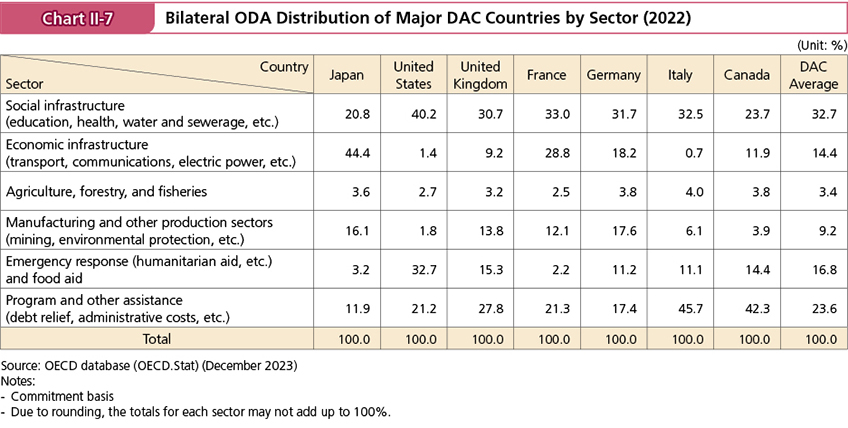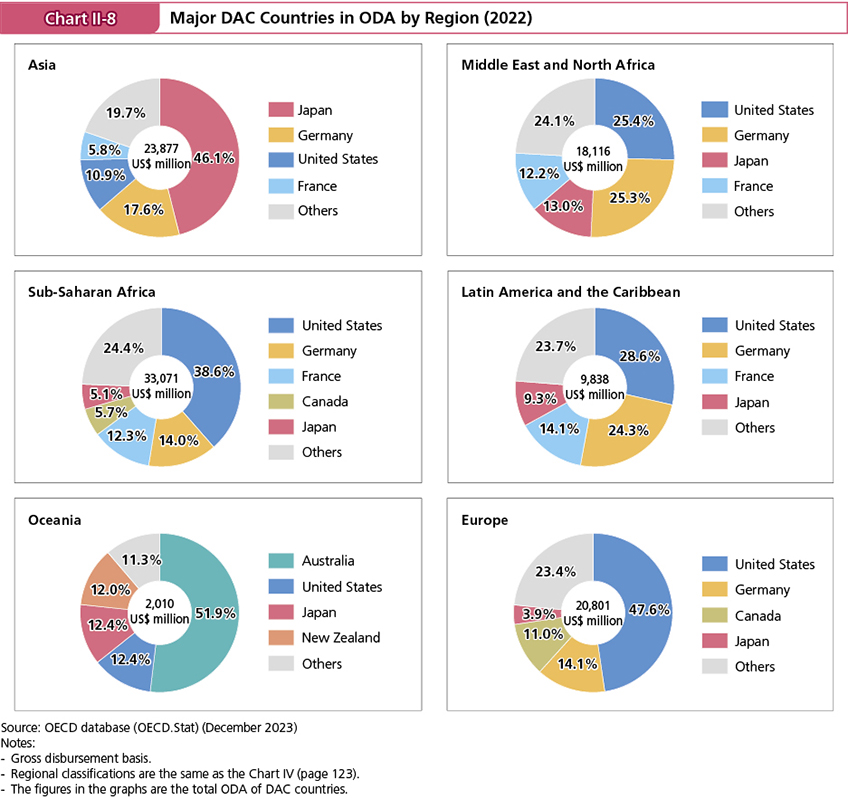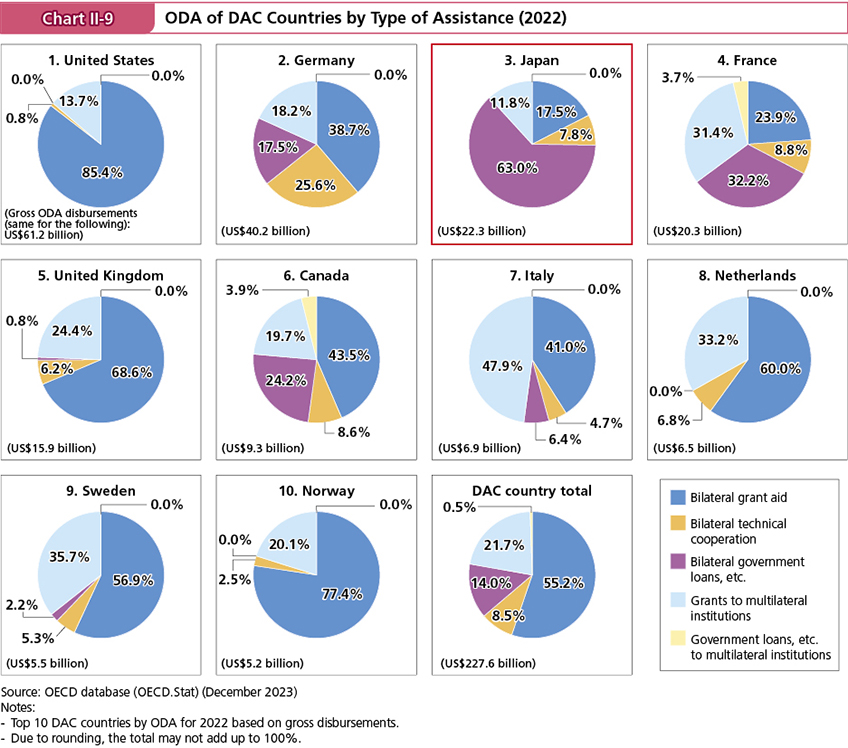2 Overview of Official Development Assistance from Major Donors in Terms of Disbursement
The OECD-DAC establishes international rules on what cooperation constitutes ODA and how it should be reported. Under the rules set by the DAC, ODA must meet the following three requirements: (i) it is provided by official agencies or their executive agencies; (ii) its main objective is to promote the economic development and welfare of developing countries; and (iii) it is concessional in character (in the case of government loans, the terms of the loan [e.g., interest rate and repayment period] are set in favor of the recipient countries).
DAC countries provide development cooperation under the rules set by the DAC. However, the content of ODA implemented by major donors varies by country. This section outlines the aid provided by DAC donors, focusing on the G7 countries, based on their disbursements in 2022.
■ Aid Disbursements by Major Donors
ODA provided by DAC countries in 2022 (calculated by GE system) amounted to approximately 210,660 million US dollars. By country (GE system, percentage out of total ODA of DAC countries), the United States ranked first (approximately 60,522 million US dollars, 28.7%), Germany second (approximately 35,640 million US dollars, 16.9%), Japan third (approximately 17,500 million US dollars, 8.3%), France fourth (approximately 16,014 million US dollars, 7.6%), the United Kingdom fifth (approximately 15,762 million US dollars, 7.5%), Canada sixth (approximately 7,836 million US dollars, 3.7%), Italy seventh (approximately 6,646 million US dollars, 3.2%), the Netherlands eighth (approximately 6,470 million US dollars, 3.1%), and Sweden ninth (approximately 5,458 million US dollars, 2.6%), with the G7 countries occupying the top spots.Note 6
■ Sectors Aided by Major Donors
Disbursements in 2022 from the United States, the United Kingdom, France, Germany, Italy, and Canada were concentrated in the social infrastructure sectors, including education, health, and water supply and sewerage. The United States allocated more than 30% of total ODA to emergency response (humanitarian aid, etc.) and food aid. On the other hand, in the economic infrastructure sectors, such as roads, bridges, railroads, communications, and electric power, Japan has the highest allocation with 44.4% of its total ODA, followed by France with 28.8%. Economic infrastructure assistance makes up a large share of Japan’s cooperation because Japan, with its postwar recovery experience, considers that, in order to achieve poverty reduction and other goals through sustainable economic growth in developing countries, it is essential first and foremost to establish economic infrastructure and support the self-help efforts of developing countries (Chart II-7).

■ Regions Aided by Major Donors
Whereas Japan’s ODA is primarily directed at the Asian region (approximately 56.0% of gross disbursements in 2022 [hereinafter the same]) (Chart II-2), Sub-Saharan Africa was the top recipient of aid from the United States, the United Kingdom, France, Germany, and Italy (24.2%, 12.4%, 30.9%, 14.1%, and 13.8%, respectively), and Europe was the top recipient of aid from Canada (32.0%).Note 7 In terms of the percentage of total aid disbursements from major DAC countries by region, the United States was the largest donor to the Middle East and North Africa (25.4%), Sub-Saharan Africa (38.6%), Latin America and the Caribbean (28.6%), and Europe (47.6%). Australia provided 51.9% of total ODA to Oceania. As these figures indicate, the regional priority of each donor is influenced by factors such as geographic proximity and historical background (Chart II-8).

■ Disbursements by Type of Assistance
By type of assistance, approximately 85.5% of ODA provided by all DAC countries in 2022 were grants (bilateral grant aidNote 8: approximately 55.2%; bilateral technical cooperation: approximately 8.5%; grants to multilateral institutions: approximately 21.7%), and approximately 14.5% were government loans, etc. (bilateral loans: approximately 14.0%; loans to multilateral institutions: approximately 0.5%). With the exception of Japan, France, and Canada, the top 10 major DAC countries implemented most of their ODA as grants (bilateral grant aid, bilateral technical cooperation, and grants to multilateral institutions) (Chart II-9).
Loan aid (e.g., yen loan) accounts for a large share of Japan’s ODA because Japanese assistance aims to support developing countries’ self-reliant efforts to achieve economic growth. This is based on the idea that effective development cooperation requires awareness raising that development is not granted; rather, it is something developing countries take ownership of. From the viewpoint of developing countries, they carry out projects aimed at their social and economic development with the funds they have borrowed. This in turn encourages the countries to work hard on their projects. Japan’s cooperation strives to enable the people of developing countries to sustain and evolve the projects on their own even after Japan’s yen loan projects are completed. This approach is unique to Japan, which places importance on self-help efforts.

- Note 6: OECD database (OECD.Stat) (December 2023)
- Note 7: OECD database (OECD.Stat) (December 2023)
- Note 8: Bilateral grant aid refers to grant aid, debt relief, and grants through multilateral institutions, etc., in Chart II-1.
